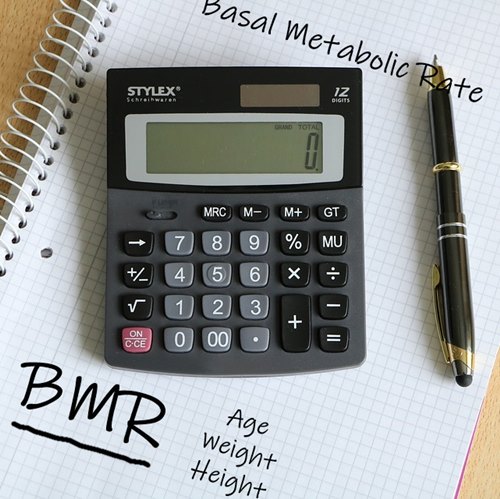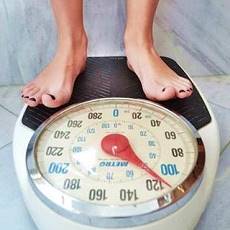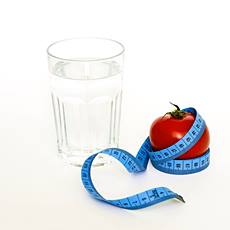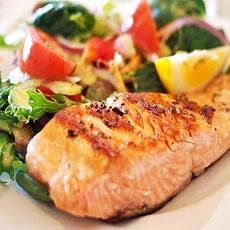Basal Metabolic Rate Calculator
Resting Metabolic Rate
Calculate your Basal Metabolic Rate or BMR also called Resting Metabolic Rate or RMR, with our online calculator tool.
Learn how to use it as a starting point for your weight loss program.
We will also address the urban myth that states that a caloric deficit of 3,500 Cal. per week equals one pound of fat in weight loss.
Learn about how BMR varies due to age, gender, ethnic origin, and body build.
Find out about its margin of error and the other methods used to calculate it.

Photo: A. Whittall
What is the Resting Metabolic Rate or RMR?
Definition of Resting Metabolic Rate
What exactly does RMR (or Basal Metabolic Rate - BMR) mean anyway?
RMR is the rate at which your body burns energy when it is resting (its only activities under these circumstances are breathing, blood circulation, and brain activity).
It has two main components:
1. Essential Energy Expenditure
The energy used by your body to keep your body's cells working properly: their structure, their function, their internal biochemical processes, the gradients in calcium and sodium ions, and protein assembly.
2. Constant Body Temperature
We are "warm-blooded" animals, meaning that our body keeps a constant temperature (this is also known as homeothermy from the Greek words "homo" = "the same" or "equal" and "thermos" = "warm").
Constant body temperature requires a lot of energy, roughly two-thirds of BMR goes into homeothermy.
For instance, a mouse weighing the same as a "cold-blooded" lizard burns 8 to 10 times more energy to maintain its body temperature (1).
How is this energy generated?
There are small organelles inside each of your body cells, these are called mitochondria. They regulate metabolism by generating energy in a process known as respiration. The thyroid hormones regulate them.
Energy, RMR, and Weight
Metabolism is a series of chemical reactions that keep our body alive, they take place within our body's cells. Metabolism is an ongoing process, that only stops with death.
These bodily chemical reactions require energy, which our body obtains from the food we eat.
The body intakes fats, carbohydrates, and protein from food and breaks them down into their building blocks, different types of fatty chains, sugars, and amino acids.
These nutrients are then reacted with oxygen inside our cells to generate energy and the surplus energy is stored mainly as fat or glycogen (a type of sugar), or as protein (Fat-Free Mass) in our muscles.
This is the basic equation governing metabolism:
Energy Intake = Energy Output + Storage
And it is useful to know if you want to lose weight. Read on to learn why.
Our BMR Calculator
How does the calculator work?
With our calculator, you can find out which is your Basal Metabolic Rate or BMR, also known as Resting Metabolic Rate or RMR.
We will use both terms "RMR" and "BMR" interchangeably because the scientific papers do the same.
We use the formula that is known as the Harris-Benedict Equation, and which dates back to 1919. It has its margin of error (which we discuss further down), but it will give you a good estimation of your RMR.
In case you are curious, this is the formula (wt is weight, and ht is height.)
- BMR (men) = 66 + (13.7 x wt in kg) + (5 x ht in cm) - (6.8 x age in years)
- BMR (women) = 655 + (9.6 x wt in kg) + (1.8 x ht in cm) - (4.7 x age in years)
Remember that the BMR calculator is just an estimation and that other methods can be used to calculate it.
For instance, one that measures how much oxygen you breathe in and the carbon dioxide that you exhale, and based on these values, it calculates the actual energy burned by your body over a given period.
To use our RMR calculator you only need to know your height, your weight, your age, and your gender.
You can also calculate your TotalTotal Daily Energy Expenditure or TDEE based on your average daily energy output, and this is defined by your lifestyle and level of physical activity:
- Sedentary: little or no exercise, desk job
- Lightly active: light exercise or sports 1-3 days a week
- Moderately active: moderate exercise or sports 6-7 days weekly
- Very active: hard strenuous exercise every day, or exercising twice a day
- Extra active: vigorous exercise 2 or more times per day; or training for a marathon, triathlon, etc.
The BMR Calculator
Please fill all the required fields.
Notes on our BMR Calculator
Values in Kilocalories abbreviated Cal., also called Calories (both with capital "C").
The lower figure is your Rest Metabolic Rate or RMR - BMR, the higher figure is your current total energy requirement based on your level of activity.
This calculator is for adults only. Not for pregnant women. Medical Disclaimer page for full details on the scope of the information provided on our website.
Use the BMR calculator to lose weight
The Basal Metabolic Rate is just a part of the energy your body consumes. Your daily activities also require energy expenditure (walking, sleeping, taking a shower, thinking, eating, cooking, etc.).
The Total Daily Energy Expenditure or TDEE is the total amount of calories burned daily and it depends on your lifestyle. Our BMR calculator takes this into account and multiplies the BMR by a coefficient to add on the extra energy required depending on your type of activity (from sedentary to extra active).
So knowing your daily energy requirements can help you adjust your daily food intake (Energy Intake) or your level of activity (Energy Output) to stop storing fat and begin consuming your stores, to lose weight.
A lower intake of energy is known as "Calorie Deficit" which means eating fewer calories than your TDEE requirements. The deficit will be covered by burning stored energy (fat).
An additional deficit can be generated by increasing metabolism through exercise: making your body burn more energy.
And this is what led to the inaccurate urban myth that states that a weekly calorie deficit of 3,500 calories will let you lose one pound of fat.
The Rule of 1 pound of fat equals 3,500 Calories
The truth behind the rule of the thumb is that it is not very accurate. Below we will explain why.
Wishnofsky's Rule
Remember the energy equation?
Energy Intake = Energy Output + Storage
When energy intake is equal to the output you are in an energy balance, and there is no change in the energy stored as fat.
When you burn more energy (exercise) or lower your energy input (diet to eat less) your body will burn stored energy (fat) to maintain its energy balance to satisfy its metabolic needs.
But what is the relationship between fat loss and energy deficit?
The famous rule that states that "3,500 calories are equivalent to one pound of fat" comes from a report published by Max Wishnofsky in 1958.
Wishnosfky asked "What is the caloric equivalent of one pound of body weight gained or lost?" and his conclusion was what we find mentioned in thousands of websites: 3,500 Kcal equals one pound of fat (Thomas, 2014) (2).
What exactly does this mean?
Wishnofsky's Rule implies that if you:
- Reduce your energy intake by "X" calories daily, or
- Increase your energy output (by being more physically active) by "Y" calories daily,
- Or do both things together,
You can calculate how much weight you will lose by adding up the caloric deficit X plus the extra calories burned Y and dividing it by 3,500. The result will be your daily weight loss in pounds of fat:
Let's see a simple example using an imaginary subject called Jane.
Jane's Basal Metabolic Rate is 1,400 Calories. Her sedentary lifestyle requires an additional 280 Calories to cover her energy output during her daily activities. So her Total Daily Energy Expenditure (TDEE) is 1,680 Calories.
Let's imagine that she will go on a diet that will restrict her caloric intake by 20%. That is she will eat1,680 x 0.2 = 336 fewer Calories each day.
Jane will also increase her levels of physical activity by walking 2 miles per day at a brisk pace, this means that she will burn an additional 120 Calories daily.
So Jane will burn 120 extra Calories and reduce her intake by another 336 Calories. This adds up to 456 Calories.
After one week of dieting, this adds up to 456 x 7 = 3,192 Calories.
These calories will have come from "burning" her fat stores which, according to Wishnofsky's Rule means that she will have lost:
3,192⁄3,500 = 0,91 lb. of fat.
Wishnofsky's Rule isn't accurate
The rule is inaccurate because it ignores some basic facts of what happens when people go on a diet.
According to Thomas (2014)(2), reducing caloric intake without increasing energy output leads to a "two-phase" weight loss situation:
1. Rapid weight loss phase
During the first few days, or weeks the body uses its energy stores to cover the caloric deficit. This leads to a rapid weight loss because the body burns glycogen (and each ounce of glycogen is associated with 3-4 ounces of water: burning half a pound of glycogen generates 1.5 to 2 lb. of water which is excreted as urine), protein and some (but not much) fat.
The quick loss of body mass is due to the loss of water. Water is bound up into the protein and the glycogen reserves stored in the body. As the body burns them, it separates them from the water, which is then excreted in the urine.
A 24-week-long study at Pennington Biomedical Research Center (2), the CALERIE I Study, found that the energy content of weight change was only 2,208 Calories⁄lb; of fat. This is far lower than Wishnofsky's value.
2. Second phase: slow loss
This stage can last for several months, even years. During this phase, the body burns carbohydrates from the food eaten during the diet and the glucogenic amino acids in the protein. So now the body starts burning its fat stores. But this causes a much slower weight loss.
In the CALERIE I study, the energy required to burn a pound of fat increased during this stage to 2,986 Calories⁄lb.
Although it was higher than the phase one value, it was still lower than Wishnofsky's prediction.
The body also adapts to the lower energy intake by slowing down its energy output: the body becomes more efficient in using its available energy, so the resting energy expenditure (BMR) is lower now than it was before the diet began.
Remember, your body's objective is to maintain a stable weight so it will do all it can to keep it from dropping (3).
Furthermore, as the diet progresses and body mass decreases, the amount of body tissue that requires metabolic energy also decreases.
Weight loss starts to slow down, and the diet reaches a plateau as the body balances inputs with outputs.
A study by Hall (2008) (4) also looked into Wishnofsyk's Rule and came to the following conclusions:
- Men can lose more weight than women for a given energy deficit because women typically have more body fat than men of similar body weight.
- The rule is quite a good fit for obese subjects with more than 60 lb. of fat.
- The rule overestimates the energy deficit required per unit of weight loss in the case of leaner people.
They also reported that people with more body fat would require a larger energy deficit to lose the same amount of weight as leaner people.
The reason for this is the energy content of the body's stores:
- 1,559 Cal⁄lb of Glycogen
- 1,746 Cal⁄lb ofProtein
- 3,500 Cal⁄lb of Fat
So if we have a man and a woman with the same body mass, men tend to have less fat and more muscle (protein and glycogen).
Both men and women's stores of glycogen and protein will be the first to be consumed during "Phase One".
Women's glycogen and protein stores will be gone quickly because they have fewer of them than men. So they will then switch to burning fat ("Phase Two").
Men will keep on burning protein and glycogen. But these have a lower energy content per pound than fat, so men will have to burn more pounds of glycogen or protein to cover the energy requirements in comparison to women, who will be only burning fat.
So a man will lose 2.24 lb of body mass by burning glycogen or 2 lbs by burning fat protein while a woman will only lose 1 lb of fat mass to cover the same energy deficit.
Is there a Normal Range for BMR?
As we will see below, many factors influence Basal Metabolic Rate such as gender, age, body build, and body fat (proportion and location), this means that people have different BMRs.
So no, there is no normal range for basal metabolic rate. For that reason, we don't provide a Basal Metabolic Rate chart either. It has no point.
Can You modify your BMR?
Metabolic Rate changes if you modify your body weight and how much fat your body stores, it also changes with age (more on this below). But there is not much you can do to modify your BMR.
Diet Tip
Muscle loss during a diet will cause a drop in your metabolic rate (because the loss means there is less tissue requiring energy). Fat loss on the other hand does not affect the metabolic rate (fat cells don't consume energy, they are mere "storage bins").
If you are dieting, your goal is not to lose muscle mass, because if your metabolic rate falls, you will be "burning" fewer calories than before.
Maintain your muscles by eating protein and exercising.
Factors affecting Metabolic Rate
The original RMR (Resting Metabolic Rate) of adults was calculated over one century ago by J.A. Harris and F. G. Benedict at the Carnegie Institution. (1919) (5). They studied 103 white men and 103 white women, so its ethnic scope was limited. Also, lifestyles have changed over the past 100 years.
Race, age, gender, climate, temperature all influence the value of RMR; McMurray (2014) (6) looked into some of these factors and found that:
- African American children have an RMR that is 10-20% lower than Caucasians.
- Fat stores are lower in African Americans vs. Caucasians or Hispanics, and different organ weights in different ethnic groups influence RMR.
- The location of fat mass also affects RMR.
- Fitness (aerobic fitness and physical activity level) influences RMR.
- Women have a lower RMR than men.
Young men with a normal weight had the highest RMR. As men grow older and Body Mass Index (BMI) increases (they grow fatter), the RMR drops proportionately.
Women also had their highest RMR when young and lean, and RMR also decreased with an increase in BMI.
Finally, regardless of sex, obese adults (BMI = 30) had the lowest RMR; it was 15% lower than that of fitter adults.
Effect of Temperature on Metabolic Rate
Landsberg's team (2005) (1) mentions that RMR is higher in colder climes (Arctic) in comparison to the tropics, where it is lower. This is quite logical, considering that the body will have to burn more energy to maintain its core temperature constant in a cold climate.
Body temperature also increases RMR: people running a fever speed up their metabolism and a rise of 1.8°F due to fever can lead to an increase of 10-13% in RMR.
Errors in Harris-Benedict's Basal Metabolic Rate Formula
There is no single RMR that fits all adults, and Harris-Benedict's formula has a margin of error. Lee and Kim (2012) (3) stated that this error ranges from more or less 5% to 15% higher than the actual BMR. McMurray (2014) (6) estimates the overestimation at 10% for men, 15% for women, and up to 20% - 30% for some ethnic and body size combinations.
Other alternative equations can be used to calculate energy expenditure. One of them is the Mifflin St Jeor equation:
Mifflin St Jeor Equation
The Mifflin St Jeor equation is another basal metabolic rate formula. As its name implies this formula was proposed by a team led by M. D. Mifflin and S. T. St Jeor, in 1990(7).
They studied a group of 247 women and 251 men, whose ages ranged from 19 to 78 years. The group included normal-weight subjects and obese subjects. Their tests led to the following set of equations:
Instead of BMR or RMR, this equation uses the term: Resting Energy Expenditure or REE
- REE (men) = 10 x weight (kg) + 6.25 x height (cm) - 5 x age (yr) + 5
- REE (women) = 10 x weight (kg) + 6.25 x height (cm) - 5 x age (yr) - 161.
We can translate that into pounds and inches:
- REE (men) = 22.04 x weight (lbs) + 15.88 x height (in) - 5 x age (yr) + 5
- REE (women) = 22.04 x weight (lbs) + 15.88 x height (in.) - 5 x age (yr) - 161.
Yet, like all general equations, it also has its limitations, Frankenfield (2005) (8) gave it a margin of error of 10%, which is the narrowest in comparison to other BMR formulas (such as the Harris-Benedict, Owen, or the World Health Organization - Food and Agriculture Organization - United Nations University).
Closing Comments
The BMR tool is approximate and depends on many factors: age, sex, body type, ethnicity, etc. But it is a reasonable rule of thumb to calculate your resting metabolism rate.
Knowing your Basal Metabolic Rate is important if you want to lose weight. Combined with your current or planned level of physical activity it can help you know your body's energy requirements.
With these requirements, you can then set a goal for energy deficit (caloric deficit) by both reducing your daily intake of food with a balanced diet and, increasing your energy expenditure by exercising more.
The well-known rule that says that a deficit of 3,500 Calories per week will lead to a loss of 1 pound of fat is inaccurate: fat loss depends on many factors and should be taken as a rough approximation.
References and Further Reading
(1) L. Landsberg, J.B. Young, W. R. Leonard, R.A. Linsenmeier, F. W. Turek (2009). Do the Obese Have Lower Body Temperatures? A New Look at a Forgotten Variable in Energy Balance.Trans Am Clin Climatol Assoc. 2009; 120: 287-295
(2) Diana M. Thomas, et al., (2014). Time to Correctly Predict the Amount of Weight Loss with Dieting.J Acad Nutr Diet. 2014 Jun; 114(6): 857-861. 2014 Mar 31. doi:10.1016/j.jand.2014.02.003
(3) Sun Hee Lee, Eun Kyung Kim, (2012). Accuracy of Predictive Equations for Resting Metabolic Rates and Daily Energy Expenditures of Police Officials Doing Shift Work by Type of Work.Clin Nutr Res. 2012 Jul; 1(1): 66-77. 2012 Jul 26. doi:10.7762/cnr.2012.1.1.66
(4) Kevin D. Hall. (2008). What is the Required Energy Deficit per unit Weight Loss?. Int J Obes (Lond). 2008 Mar; 32(3): 573-576. 2007 Sep 11. doi:10.1038/sj.ijo.0803720
(5) Harris JA, Benedict FG. (1919) A biometric study of basal metabolism in man. Carnegie Institution; Washington DC
(6) R. G. McMurray, J. Soares, C.J. Caspersen, T. McCurdy (2014). Examining Variations of Resting Metabolic Rate of Adults: A Public Health Perspective.Med Sci Sports Exerc. 2014 Jul; 46(7): 1352-1358. doi:10.1249/MSS.0000000000000232
(7) M D Mifflin, S T St Jeor, L A Hill, B J Scott, S A Daugherty, Y O Koh, (1990). A new predictive equation for resting energy expenditure in healthy individuals.The American Journal of Clinical Nutrition, Vol 51: 2, 1 February 1990, 241-247, https://doi.org/10.1093/ajcn/51.2.241
(8) D. Frankenfield, L. Roth-Yousey, C. Compher, (2005). Comparison of predictive equations for resting metabolic rate in healthy nonobese and obese adults: a systematic review. J Am Diet Assoc. 2005 May;105(5):775-89
About this Article
Basal Metabolic Rate Calculator, A. Whittall
©2018 Fit-and-Well.com, 11 Oct. 2018. Updated. 14 Nov. 2020. https://www.fit-and-well.com/resources/calculate-rest-metabolism.html
Tags: BMR Calculator, Basal Metabolic Rate, Resting Metabolic Rate, RMR, BMR formula, BMR equation, BMR and weight loss, Waist Size.
This Webpage
Subject: Fit-and-Well.com. Basal Metabolic Rate (BMR) Calculator. What is it, and how is it calculated? Some pros and cons. The margin of error. How to use it for weight management.






